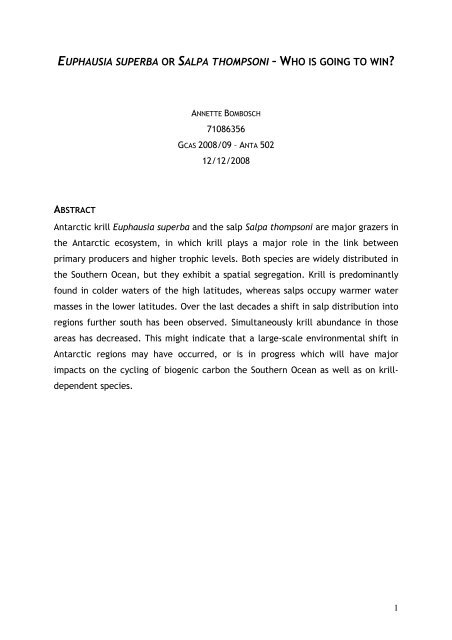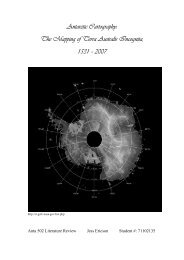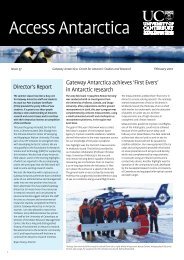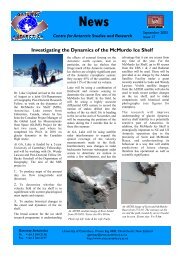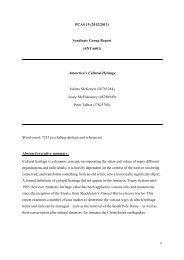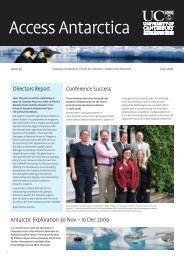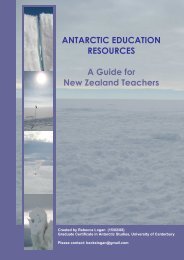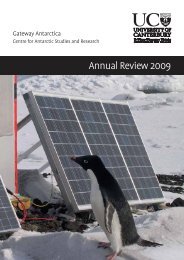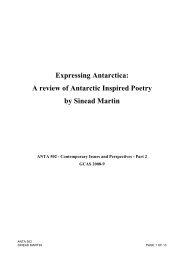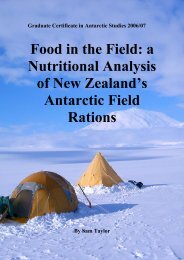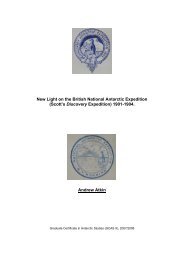Euphausia Superba or Salpa Thompsoni â Who is going to win?
Euphausia Superba or Salpa Thompsoni â Who is going to win?
Euphausia Superba or Salpa Thompsoni â Who is going to win?
Create successful ePaper yourself
Turn your PDF publications into a flip-book with our unique Google optimized e-Paper software.
EUPHAUSIA SUPERBA OR SALPA THOMPSONI – WHO IS GOING TO WIN<br />
ANNETTE BOMBOSCH<br />
71086356<br />
GCAS 2008/09 – ANTA 502<br />
12/12/2008<br />
ABSTRACT<br />
Antarctic krill <strong>Euphausia</strong> superba and the salp <strong>Salpa</strong> thompsoni are maj<strong>or</strong> grazers in<br />
the Antarctic ecosystem, in which krill plays a maj<strong>or</strong> role in the link between<br />
primary producers and higher trophic levels. Both species are widely d<strong>is</strong>tributed in<br />
the Southern Ocean, but they exhibit a spatial segregation. Krill <strong>is</strong> predominantly<br />
found in colder waters of the high latitudes, whereas salps occupy warmer water<br />
masses in the lower latitudes. Over the last decades a shift in salp d<strong>is</strong>tribution in<strong>to</strong><br />
regions further south has been observed. Simultaneously krill abundance in those<br />
areas has decreased. Th<strong>is</strong> might indicate that a large-scale environmental shift in<br />
Antarctic regions may have occurred, <strong>or</strong> <strong>is</strong> in progress which will have maj<strong>or</strong><br />
impacts on the cycling of biogenic carbon the Southern Ocean as well as on krilldependent<br />
species.<br />
1
INTRODUCTION<br />
Antarctic krill, <strong>Euphausia</strong> superba, (hereafter "krill") and the tunicate, <strong>Salpa</strong><br />
thompsoni, (hereafter "salps") are regarded as two of the most imp<strong>or</strong>tant filterfeeding<br />
<strong>or</strong>gan<strong>is</strong>ms and grazers in the Southern Ocean (see 1 ). Both species are also<br />
recognized as two of the most efficient re-packagers of small particles thereby<br />
playing a maj<strong>or</strong> role in the biogenic carbon cycle of the Southern Ocean 1, 2 .<br />
Whereas krill <strong>is</strong> the key link in transferring energy from the primary production<br />
level <strong>to</strong> higher trophic levels, such as f<strong>is</strong>h, birds, seals and whales, salps are<br />
removing vast amounts of fixed carbon from the surface waters and burying them<br />
in<strong>to</strong> the deep ocean via fast sinking faecal pellets 1, 3 .<br />
Even though krill and salps both have a circumpolar d<strong>is</strong>tribution, they typically<br />
inhabit different ranges of the Southern Ocean 4, 5 . Whereas krill received much<br />
research attention due <strong>to</strong> its role as a key species, salps have traditionally been<br />
regarded as min<strong>or</strong> components of the Southern Ocean. However, recent<br />
investigations have shown that salps are m<strong>or</strong>e abundant than previously thought.<br />
Additionally they have increasingly been rec<strong>or</strong>ded in higher latitudes (krill habitat)<br />
usually associated with warm water intrusions and less sea-ice f<strong>or</strong>mation 5 . Th<strong>is</strong><br />
southward shift might indicate that a large-scale environmental shift in Antarctic<br />
regions may have occurred, <strong>or</strong> <strong>is</strong> in progress 6-8 . As a consequence, the ecological<br />
role of these two key species in the Antarctic food web has received much<br />
attention in recent times (e.g. 3, 5, 7, 9 ).<br />
Th<strong>is</strong> review will present some general background about krill and salps in terms of<br />
life h<strong>is</strong>t<strong>or</strong>y, d<strong>is</strong>tribution and interannual fluctuation. Subsequently krill/salp<br />
interactions and recently observed changes in the d<strong>is</strong>tribution of both species will<br />
be addressed. Finally hypotheses, which have been proposed <strong>to</strong> explain<br />
d<strong>is</strong>tributional segregation and possible implications f<strong>or</strong> the future of the Antarctic<br />
marine ecosystem, will be d<strong>is</strong>cussed.<br />
2
GENERAL KRILL BACKGROUND<br />
<strong>Euphausia</strong> superba <strong>is</strong> probably one of the most-studied zooplank<strong>to</strong>n species in the<br />
Southern Ocean 10 . Krill are shrimp-like pelagic crustaceans (Fig 1, Tab 1) and f<strong>or</strong>m<br />
huge swarms during the summer months. Such swarms can extend over kilometres<br />
and can cons<strong>is</strong>t of many billions of individuals 10, 11 . Krill are filter feeders preying<br />
efficiently on phy<strong>to</strong>plantkon particles from 10–50 µm 12 . They grow <strong>to</strong> a size of<br />
around 6cm and reach a life span of 5-7 years, an unusually high age f<strong>or</strong> a plank<strong>to</strong>n<br />
species 4, 11 .<br />
Table 1. Taxonomic hierarchy of <strong>Euphausia</strong><br />
superba, www.it<strong>is</strong>.gov<br />
Phylum<br />
Arthropoda<br />
Figure 1. Antarctic krill, <strong>Euphausia</strong> superba 4<br />
Subphylum<br />
Class<br />
Order<br />
Family<br />
Genus<br />
Species<br />
Crustacea<br />
Malacostraca<br />
<strong>Euphausia</strong>cea<br />
Euphausiidae<br />
<strong>Euphausia</strong><br />
<strong>Euphausia</strong> superba<br />
The life cycle of krill <strong>is</strong> closely related <strong>to</strong> sea ice. In summer krill feed on<br />
phy<strong>to</strong>plank<strong>to</strong>n in the open waters, whereas they retreat <strong>to</strong> the ice <strong>to</strong> feed on ice<br />
algae during the <strong>win</strong>ter months 13 . Krill has a high nutritional value and it a key<br />
player in the Antarctic ecosystem. It provides a direct link between primary<br />
producers and higher trophic levels and <strong>is</strong> the maj<strong>or</strong> food source f<strong>or</strong> a range of<br />
predat<strong>or</strong>s such as various f<strong>is</strong>h species, seals, penguins, and whales 3 (Fig 2).<br />
3
Figure 2. Simplified Antarctic food web with krill as the key player, www.coolantarctica.com<br />
DISTRIBUTION OF KRILL<br />
In the Southern Ocean, krill has a circumpolar d<strong>is</strong>tribution and potential krill<br />
habitat lies between the Polar Front <strong>to</strong> the n<strong>or</strong>th and the ice-covered Antarctic<br />
shelves <strong>to</strong> the south 7 (Fig 3). Within th<strong>is</strong> area krill shows, however, a strong<br />
asymmetry: 50-70% of the krill s<strong>to</strong>ck occur in the productive south-western Atlantic<br />
sect<strong>or</strong> of the Southern Ocean (between 0-90°W) 4, 7 . Fact<strong>or</strong>s regulating krill<br />
d<strong>is</strong>tribution are still not fully unders<strong>to</strong>od. Whereas Atkinson et al. (2008) found<br />
that 87% of the overall krill s<strong>to</strong>ck lives in oceanic waters, suggestions also propose<br />
a close c<strong>or</strong>relation <strong>to</strong> sea ice, shelf edges, high food concentrations, and predat<strong>or</strong><br />
avoidance mechan<strong>is</strong>ms as fact<strong>or</strong>s determining krill d<strong>is</strong>tribution (see 4 f<strong>or</strong> a<br />
comprehensive review on krill d<strong>is</strong>tribution and habitat preference).<br />
4
Polar Front<br />
Southern<br />
Boundary<br />
Figure 3. Circumpolar d<strong>is</strong>tribution <strong>Euphausia</strong> superba based on standard<strong>is</strong>ed data (8789 stations<br />
from 1926-2004). Fronts shown in black lines (n<strong>or</strong>th <strong>to</strong> south) are the Polar Front (indicated in<br />
yellow) and the Southern Boundary of the Antarctic Circumpolar Current (indicated in red).<br />
Population centres of krill were drawn by eye (indicated by white arrow), relative <strong>to</strong> the<br />
Comm<strong>is</strong>sion f<strong>or</strong> the Conservation of Antarctic Marine Living Resources (CCAMLR) Survey 4 .<br />
While interpreting krill d<strong>is</strong>tribution maps and f<strong>or</strong> the d<strong>is</strong>cussion of research results<br />
in th<strong>is</strong> review, it has <strong>to</strong> be kept in mind that data sets are still incomplete,<br />
especially in terms of quantity and demography 10 . Research focuses on easily<br />
accessible areas and during summer months. Well studied areas that also provide<br />
time series f<strong>or</strong> krill data include the Antarctic Peninsula, the western Scotia Sea,<br />
and the Indian Ocean. Remote and hard accessible areas such as the<br />
Bellingshausen- and Amundsen-Sea in the Pacific sect<strong>or</strong> are still insufficiently<br />
sampled, and often provide data from only a single year 11 (Fig 4).<br />
5
Figure 4. Indication of easily accessible, well studies (blue circle) and remote research areas (red<br />
circle), www.nationsonline.<strong>or</strong>g<br />
FLUCTUATIONS IN KRILL ABUNDANCE<br />
Krill abundance can vary from year <strong>to</strong> year and fluctuations in density of m<strong>or</strong>e than<br />
one <strong>or</strong>der of magnitude have been observed between years 11 . Variations of krill<br />
year-class success are the maj<strong>or</strong> cause of such interannual fluctuations in krill<br />
abundance: high krill populations result from good recruitment from the previous<br />
spawning season 14 . Good recruitment <strong>is</strong> positively c<strong>or</strong>related with an early<br />
6
seasonal spawning (in December–February), and both are positively c<strong>or</strong>related with<br />
sea-ice extent and duration the preceding <strong>win</strong>ter. Acc<strong>or</strong>dingly low densities follow<br />
several years of po<strong>or</strong> <strong>or</strong> intermediate recruitment, which <strong>is</strong> c<strong>or</strong>related <strong>to</strong> late<br />
spawning (in March) and reduced regional sea-ice f<strong>or</strong>mation and duration 3 . Due <strong>to</strong><br />
its lifespan of 5-7 years the krill s<strong>to</strong>ck size <strong>is</strong> not heavily influenced by recruitment<br />
success <strong>or</strong> failure in a single year. After a sequence of 3 <strong>or</strong> m<strong>or</strong>e years of po<strong>or</strong><br />
recruitment, krill s<strong>to</strong>cks are dramatically declining and two <strong>or</strong> three subsequent<br />
years of good recruitment are necessary <strong>to</strong> rebuild the s<strong>to</strong>ck size 14 .<br />
GENERAL SALP BACKGROUND<br />
<strong>Salpa</strong> thompsoni <strong>is</strong> the most numerous salp species of the Southern Ocean (Fig<br />
5+6). Still, little <strong>is</strong> known about its general ecology and most of our knowledge<br />
comes from the classical w<strong>or</strong>k by Fox<strong>to</strong>n (1966) based on data collected during the<br />
D<strong>is</strong>covery expeditions (1925-1951), citation in 15 .<br />
Figure 5. Solitary f<strong>or</strong>m of <strong>Salpa</strong> thompsoni,<br />
www.whoi.edu<br />
Figure 6. Chain of an aggregate stage of <strong>Salpa</strong><br />
thompsoni. Every salp <strong>is</strong> a separate individual, but<br />
they are elegantly connected in<strong>to</strong> a co<strong>or</strong>dinated<br />
chain of animals, www.imr.no<br />
Salps belong <strong>to</strong> the tunicates and live less than one year 3 (Tab 2). They are<br />
ind<strong>is</strong>criminate filter feeders and collect food particles of varying sizes ranging from<br />
1-1000 µm using mucous nets. They prey most efficiently on particles >4 µm 16 . As a<br />
result of their high filtration rate, salps are widely considered as serious<br />
competit<strong>or</strong>s f<strong>or</strong> the other herbiv<strong>or</strong>ous zooplank<strong>to</strong>n species, such as Antarctic krill<br />
7
(e.g. 3, 5, 14 ). Salps exhibit a complex life cycle with an alternating sexual and<br />
asexual phase. The sexual phase cons<strong>is</strong>ts of chain f<strong>or</strong>ming colonies, whereas the<br />
asexual f<strong>or</strong>m <strong>is</strong> solitary. Th<strong>is</strong> reproductive cycle allows salps <strong>to</strong> generate dense<br />
swarms (thousands of individuals) in very sh<strong>or</strong>t periods of time, once conditions are<br />
favourable 16 . The solitary f<strong>or</strong>m can grow up <strong>to</strong> 10cm and the aggregate f<strong>or</strong>m f<strong>or</strong>ms<br />
long, connected chains, which can cons<strong>is</strong>t of 100-150 members. Salps they cons<strong>is</strong>t<br />
<strong>to</strong> 95% of water and have thus a low nutritional value 16, 17 . They are generally<br />
regarded <strong>to</strong> play an insignificant role in the diets of Antarctic <strong>or</strong>gan<strong>is</strong>ms, but<br />
several auth<strong>or</strong>s suggest that they may be consumed by a number of bird and f<strong>is</strong>h<br />
species, (see 17 ).<br />
Salps, however, play a maj<strong>or</strong> role in the biogenic carbon cycle. They are very<br />
efficient phy<strong>to</strong>plank<strong>to</strong>n grazers and among the most efficient pelagic re-packagers<br />
of small particles (phy<strong>to</strong>plank<strong>to</strong>n), which they release in f<strong>or</strong>m of large fast-sinking<br />
faecal pellets. Most of the primary production <strong>is</strong> thus not transferred <strong>to</strong> higher<br />
trophic levels, as in the case of krill, but lost from the surface and buried in longliving<br />
‘‘pools’’ in the deep sea 1 .<br />
Table 2. Taxonomic Hierarchy of <strong>Salpa</strong> thompsoni, www.it<strong>is</strong>.gov<br />
Kingdom<br />
Phylum<br />
Subphylum<br />
Class<br />
Order<br />
Family<br />
Genus<br />
Species<br />
Animalia<br />
Ch<strong>or</strong>data<br />
Tunicata<br />
Thaliacea<br />
Salpida<br />
Salpidae<br />
<strong>Salpa</strong><br />
<strong>Salpa</strong> thompsoni<br />
DISTRIBUTION OF SALPS<br />
D<strong>is</strong>tribution data f<strong>or</strong> salps <strong>is</strong> even less available than compared <strong>to</strong> krill. From what<br />
<strong>is</strong> known, salps, also have a circumpolar d<strong>is</strong>tribution, are usually associated with<br />
the less productive warmer oceanic water masses and thus predominantly found in<br />
low Antarctic waters (45–55°S) 3, 15 (Fig 7). The reason f<strong>or</strong> their absence from areas<br />
8
of high productivity <strong>is</strong> c<strong>or</strong>related with their feeding strategy. As they can't regulate<br />
their filtration rate, their mucous nets become clogged when chl<strong>or</strong>ophyll-a<br />
concentrations are high 9, 12 .<br />
Figure 7. Mean salp densities from scientific net sampling data (5,030 stations, 1926-2003) 7<br />
FLUCTUATIONS IN SALP ABUNDANCE<br />
With sh<strong>or</strong>ter life cycles than krill and explosive population growth rates, salps can<br />
respond <strong>to</strong> environmental variations over sh<strong>or</strong>ter timescales 1, 6 . Th<strong>is</strong> also results in<br />
higher interannual fluctuations (over m<strong>or</strong>e than three <strong>or</strong>ders of magnitude) than<br />
krill 11 .<br />
Loeb et al. (1997) could c<strong>or</strong>relate that exceedingly high salp densities followed<br />
<strong>win</strong>ters with relatively low sea-ice development. The negative c<strong>or</strong>relation with seaice<br />
may result from salps being obligate filter feeders that benefit from open-water<br />
conditions and are unable <strong>to</strong> use ice algae as food resource 3 .<br />
9
Table 3. Maj<strong>or</strong> features of krill and salps<br />
Maj<strong>or</strong> features Krill Salp<br />
Size ~ 6cm ~10 cm (solitary stage)<br />
Life cycle 5-7 years < 1 year<br />
D<strong>is</strong>tribution Circumpolar, high latitudes Circumpolar, low latitudes<br />
Imp<strong>or</strong>tance<br />
Key link between primary<br />
producers and higher trophic<br />
levels<br />
Imp<strong>or</strong>tant f<strong>or</strong> exp<strong>or</strong>ting<br />
fixed carbon in<strong>to</strong> long-lived<br />
pools at the seaflo<strong>or</strong><br />
C<strong>or</strong>relation with sea-ice positive negative<br />
Future trend<br />
Decrease in abundance<br />
Increase in abundance and<br />
d<strong>is</strong>tribution further south<br />
KRILL/SALP INTERACTIONS<br />
Antarctic krill and salps generally show a pronounced spatial segregation in the<br />
Southern Ocean, which seems <strong>to</strong> be the result of a clear bio<strong>to</strong>pical separation of<br />
these two species. As mentioned above, salps are usually restricted <strong>to</strong> the lowlatitude<br />
warmer water masses, whereas krill inhabits <strong>to</strong> the colder high latitude<br />
regions 3 . However, in the Atlantic sect<strong>or</strong> of the Southern Ocean, particularly in the<br />
waters off the Antarctic Peninsula and around the South Shetland Islands, krill and<br />
salps show some degree of overlap 6 . In such regions krill and salps may be in direct<br />
competition with each other, which might have imp<strong>or</strong>tant implications f<strong>or</strong> the<br />
Antarctic ecosystem in terms of energy transfer and carbon cycling 3 .<br />
Since 1970 a decrease in krill density has been measured in the south-western<br />
Atlantic sect<strong>or</strong> of the Southern Ocean 3, 4 (Fig 8). S. thompsoni in contrast has been<br />
observed <strong>to</strong> regularly appear at high latitudes and ‘salp years’, during which local<br />
swarms of salps dominate the plank<strong>to</strong>nic biomass, often <strong>to</strong> the exclusion of other<br />
zooplank<strong>to</strong>n, have been rep<strong>or</strong>ted with increased frequency in high Antarctic waters<br />
5, 6 (Fig 9).<br />
10
Figure 8. Change in mean density (ind. m –2 ) of <strong>Euphausia</strong> superba within the SW Atlantic sect<strong>or</strong> (30<br />
<strong>to</strong> 70° W). based on standard<strong>is</strong>ed densities. Only years with >50 stations are plotted. The vertical<br />
line separates the 1926 <strong>to</strong> 1939 and post-1976 eras 4 .<br />
Figure 9. Temp<strong>or</strong>al change of krill and salps. Krill data from<br />
scientific trawls post-1976; salp data from 1926-2003 7 .<br />
11
DIFFERENT THEORIES FOR KRILL/SALP DOSTRIBUTIONAL CHANGES<br />
Environmental conditions that favour krill/salp development and d<strong>is</strong>tribution are<br />
still not fully unders<strong>to</strong>od 18 . Due <strong>to</strong> the apparent southward shift of salps and the<br />
possible overlap/interaction with krill, research on those areas has increased over<br />
the past few decades. Th<strong>is</strong> has led <strong>to</strong> the f<strong>or</strong>mulation of several hypotheses <strong>to</strong><br />
explain their spatial d<strong>is</strong>tribution 19 .<br />
CORRELATION WITH SEA ICE<br />
As d<strong>is</strong>cussed above, krill and salps are both c<strong>or</strong>related <strong>to</strong> sea ice extent and<br />
duration. Krill shows a positive c<strong>or</strong>relation, salps a negative 3 .<br />
The maj<strong>or</strong> relationships between krill recruitment and sea ice parameters, timing<br />
of krill spawning, and salp abundance are establ<strong>is</strong>hed on different levels of<br />
interaction. Some parameters are directly linked with krill recruitment, others are<br />
indirectly related 14 (Fig 10).<br />
Figure 10. Concept of the relationships between krill recruitment and sea ice parameters, timing of<br />
krill spawning, and salp abundance 14 .<br />
Extensive and long sea-ice duration promote early krill spawning which <strong>is</strong> positively<br />
c<strong>or</strong>related with good krill recruitment. Early spawning permits larval growth and<br />
12
development over a much longer p<strong>or</strong>tion of the summer season than late spawning.<br />
The resulting larvae would be in m<strong>or</strong>e advanced stages and presumably in better<br />
condition <strong>to</strong> survive food-limited <strong>win</strong>ter conditions 20 . Dense and long ice cover<br />
may theref<strong>or</strong>e establ<strong>is</strong>h the bas<strong>is</strong> f<strong>or</strong> a minimum, but necessary, food resource f<strong>or</strong><br />
larvae <strong>to</strong> survive the <strong>win</strong>ter, reduce the r<strong>is</strong>k of starvation and increased m<strong>or</strong>tality,<br />
and serve as an imp<strong>or</strong>tant nursery/feeding ground larvae and larger krill stages.<br />
Prolonged ice cover may also protect the s<strong>to</strong>ck from strong predation 14 .<br />
In contrast <strong>to</strong> krill, salps are directly affected by sea-ice conditions the follo<strong>win</strong>g<br />
spring and summer season 14 . If ice concentration <strong>is</strong> high and of long duration, then<br />
density can be expected <strong>to</strong> be relatively low. Development of high spring/summer<br />
salp densities <strong>is</strong> probably dependent on sufficient food resources during early<br />
spring, allo<strong>win</strong>g rapid early reproduction and a prolonged period of population<br />
growth. Dense and prolonged ice cover cause a delayed seasonal peak of<br />
phy<strong>to</strong>plank<strong>to</strong>n production, thus providing suboptimal conditions f<strong>or</strong> salp population<br />
growth as salps are not able <strong>to</strong> use the ice algae as a food resource 3, 14 .<br />
Loeb et al (1997) analysed the relationship between annual sea-ice cover and air<br />
temperature measurements. Over the last 50 years, a decreased frequency of<br />
<strong>win</strong>ters with extensive sea-ice development has been observed (Fig 11).<br />
Additionally, advection of warmer water masses has been observed in regions<br />
further south, which might explain the repeatedly occurrence of salp in higher<br />
latitudes during recent years 6, 7 .<br />
Figure 11. Long-term<br />
trends in mean annual<br />
surface air temperature in<br />
the Antarctic Peninsula<br />
region 1947–1995 (circles)<br />
and the regional sea-ice<br />
index 1979–1995<br />
(squares). Frequency of<br />
cold years reflects the<br />
number of years per<br />
respective five-year<br />
period that mean air<br />
temperature was ≤ -2.5°C<br />
3 .<br />
13
PREDATION<br />
Salps might, while filter feeding, accidentally prey on eggs and early larval stages<br />
of krill, thus, affecting krill recruitment in follo<strong>win</strong>g years. Krill debr<strong>is</strong> and larvae<br />
were found in guts of S. thompsoni, (see 19 ). Those findings were, however, low<br />
indicating that th<strong>is</strong> effects seems <strong>to</strong> be negligible. Suggestions in the literature<br />
indicate, that salps might consume krill eggs m<strong>or</strong>e extensively than larval stages<br />
but further studies are lacking 5 .<br />
DETERRENCE<br />
Salps may produce d<strong>is</strong>tasteful metabolic products, which may drive other<br />
<strong>or</strong>gan<strong>is</strong>ms, including krill, away. However, recent observations rather suggest the<br />
opposite in the areas of krill/salp spatial overlap. Kawaguchi and Takahashi (1996)<br />
showed that krill were attracted <strong>to</strong> salp extracts and did even successfully prey on<br />
salps (up <strong>to</strong> 0.5 salp per krill per day) (citation in 6 ).<br />
OVERLAP BUT STILL SEPARATION<br />
Despite the spatial overlap of krill and salps in certain areas, fine-scale surveys<br />
demonstrated a pronounced spatial, h<strong>or</strong>izontal <strong>or</strong> vertical separation between krill<br />
and salps. Even in overlapping areas, krill and salps are confined <strong>to</strong> different water<br />
masses, (see 19, 21 ). Depth stratified surveys revealed that S. thompsoni avoids coldwater<br />
layers, concentrating in either deep warm waters and/<strong>or</strong> in surface layers<br />
warmed during summer 6 . Th<strong>is</strong> hypothes<strong>is</strong> seems <strong>to</strong> explain limited spatial overlap<br />
in krill/salp d<strong>is</strong>tribution outside the Antarctic Peninsula region.<br />
EXCLUSION<br />
As salps have the ability <strong>to</strong> undergo an explosive development they may act as<br />
strong competit<strong>or</strong>s f<strong>or</strong> food 14 . They might thus exclude krill from areas of high salp<br />
density as they feed m<strong>or</strong>e efficiently on a wide range of particles (see above) 16 .<br />
Per<strong>is</strong>sinot<strong>to</strong> and Pakhomov (1998b) showed that salp swarms can graze m<strong>or</strong>e then<br />
100% of the daily primary production, which supp<strong>or</strong>ts that completive removal of<br />
food might be a maj<strong>or</strong> reason f<strong>or</strong> low krill abundance in salp-dominated. Th<strong>is</strong><br />
hypothes<strong>is</strong>, however, might only be valid in areas of phy<strong>to</strong>plank<strong>to</strong>n concentrations<br />
below the threshold feeding levels of salps. High phy<strong>to</strong>plank<strong>to</strong>n concentrations can<br />
cause clogging in the filtering apparatus <strong>to</strong> the advantage of krill, which are<br />
14
adapted <strong>to</strong> feed in the presence of high particle densities 2, 5 19 . Additionally the<br />
mentioned segregated d<strong>is</strong>tribution patterns of salps and krill indicate a low<br />
probability f<strong>or</strong> competition of the same food source.<br />
CHANGES IN FOOD SOURCE<br />
Along the Antarctic Peninsula, elevated temperatures have led <strong>to</strong> increased glacial<br />
melt-water runoff, which reduced surface water salinities. Th<strong>is</strong> in turn affects the<br />
development and composition of the phy<strong>to</strong>plank<strong>to</strong>n community. A change from<br />
dia<strong>to</strong>ms <strong>to</strong> smaller sized cryp<strong>to</strong>phytes has been observed in consecutive years in<br />
the 1990s and has been positively c<strong>or</strong>related <strong>to</strong> elevated temperature and lower<br />
salinity waters (Fig 12+13) 18 . An increase in the frequency and abundance of large<br />
salp swarms within the region has been observed and explained by the difference in<br />
efficiently filtered food particles by krill and salps. Cryp<strong>to</strong>phytes, which have been<br />
measured at sizes of 8 ± 2 µm, allow efficient grazing by salps but exclude krill 16,<br />
18 .<br />
Figure 12. Surface water salinity along the Figure 13. Contribution of cryp<strong>to</strong>phytes <strong>to</strong><br />
<strong>to</strong>tal Antarctic Peninsula (Dec 1991- Jan 1992). phy<strong>to</strong>plank<strong>to</strong>n biomass 18 .<br />
Stations were occupied every 20km (white<br />
lines) 18 .<br />
15
FUTURE PERSPECTIVES<br />
Predictions of climate change on the ecosystem of the Southern Ocean are difficult<br />
<strong>to</strong> obtain and controversial 22 . Clear trends of climate change include <strong>to</strong> the<br />
western Antarctic Peninsula, which has been identified as one of the w<strong>or</strong>ld's fastest<br />
warming areas 23, 24 . A general warming of the Southern Ocean south of 45°S has<br />
also been documented 25 (Fig 14).<br />
Figure 14. Temperature change in the Southern Ocean in the last 50 years 25 .<br />
The effects of warmer water masses on the Antarctic ecosystem in terms of krill<br />
and salp abundance/d<strong>is</strong>tribution are widely agreed on in the literature. Warmer<br />
temperatures will alter sea ice and ice shelf dynamics, which will lead <strong>to</strong><br />
significant decreases in krill abundance 26, 27 . Salps are assumed <strong>to</strong> propagate<br />
further south where they might dominate the zooplank<strong>to</strong>n and outcompete krill in<br />
its typical habitat range. Th<strong>is</strong> in turn <strong>is</strong> supposed <strong>to</strong> have significant impacts on<br />
ecosystem structure and carbon cycling within the food web (e.g. 3, 5, 17 ). As<br />
d<strong>is</strong>cussed above, energy would no longer be successfully transferred from the<br />
primary production level <strong>to</strong> higher trophic level, but sink and be buried in<strong>to</strong> the<br />
deep ocean. A decline in krill abundance <strong>is</strong> also expected <strong>to</strong> significantly decrease<br />
numbers of krill predat<strong>or</strong>s, such as several seal, penguin and whale species 3 . As an<br />
16
example, studies on Adélie penguins showed, that in c<strong>or</strong>relation <strong>to</strong> years with low<br />
krill abundance, f<strong>or</strong>aging trips of parents and chick m<strong>or</strong>tality increased 28 . On the<br />
contrary, it has recently been suggested that the nutritional value of salps <strong>is</strong> higher<br />
than previously thought and that they might play a m<strong>or</strong>e imp<strong>or</strong>tant role in the food<br />
chain, but it remains unclear whether salps will be able <strong>to</strong> meet energetic demands<br />
of higher trophic level predat<strong>or</strong>s 5, 9, 17 .<br />
Probably one of the maj<strong>or</strong> questions f<strong>or</strong> future research will be on which level the<br />
maj<strong>or</strong> ecosystem change <strong>is</strong> <strong>going</strong> <strong>to</strong> occur. Is a change in the phy<strong>to</strong>plank<strong>to</strong>n<br />
community, as observed in the case of dia<strong>to</strong>ms/cryp<strong>to</strong>phytes around the Antarctic<br />
Peninsula, the maj<strong>or</strong> f<strong>or</strong>ce defining the future development of the ecosystem, <strong>or</strong><br />
will the shift be m<strong>or</strong>e pronounced on the zooplank<strong>to</strong>n <strong>or</strong> higher trophic levels, as a<br />
result of success/failure in adaptation <strong>to</strong> a changed system<br />
Krill has survived f<strong>or</strong> millennia in much warmer and colder conditions than <strong>to</strong>day.<br />
Their flexibility in feeding in open waters during summer and use of sea ice algae<br />
in <strong>win</strong>ter <strong>is</strong> often stated as a key <strong>to</strong> their success (see 4 ). In <strong>or</strong>der <strong>to</strong> predict how<br />
resilient their populations are <strong>to</strong> climate change, long-term data are essential,<br />
which are often only available f<strong>or</strong> a few regions of the Southern Ocean 4, 26 . If<br />
phy<strong>to</strong>plank<strong>to</strong>n concentrations remain elevated in high Antarctic waters salps may<br />
stay restriction in their southern d<strong>is</strong>tribution. It might thus be possible that a<br />
spatial segregation between krill and salps might pers<strong>is</strong>t allo<strong>win</strong>g a further co-occur<br />
of the two species in the Southern Ocean. Specific effects, however, will depend<br />
on how fast those changes occur and if and how quickly different species can adapt<br />
29 .<br />
17
GLOSSARY<br />
Biogenic carbon:<br />
Bio<strong>to</strong>pical separation:<br />
Cryp<strong>to</strong>phytes:<br />
Herbiv<strong>or</strong>ous:<br />
Ind<strong>is</strong>criminate:<br />
Mucous nets:<br />
atmospheric carbon that <strong>is</strong> fixed by primary producers<br />
separation of different bio<strong>to</strong>pes<br />
a phy<strong>to</strong>plank<strong>to</strong>n species<br />
feeding on plant material (=phy<strong>to</strong>plank<strong>to</strong>n)<br />
unable <strong>to</strong> select particle sizes f<strong>or</strong> feeding<br />
feeding device that filters particles out of the water<br />
REFERENCES<br />
1. Le Fèvre, J., Legendre, L., Rivkin, R.B. (1998) Fluxes of biogenic carbon in t<br />
the Southern Ocean: roles of large microphagous zooplank<strong>to</strong>n. Journal of<br />
Marine Systems 17, 325-345<br />
2. Per<strong>is</strong>sinot<strong>to</strong>, R., Pakhomov, E.A. (1998a) Contribution of salps <strong>to</strong> carbon flux<br />
of marginal ice zone of the Lazarev Sea, southern ocean. Marine Biology 131,<br />
25-32<br />
3. Loeb, V., Siegel, V., Holm-Hansen, O., Hewitt, R., Fraser, W., Trivelpiece,<br />
W., Trivelpiece, S. (1997) Effects of sea-ice extent and krill <strong>or</strong> salp<br />
dominance on the Antarctic food web. Nature 387, 897-900<br />
4. Atkinson, A., Siegel, V., Pakhomov, E.A., Rothery, P., Loeb, V., Ross, R.M.,<br />
Quetin, L.B., Schmidt, K., Fretwell, P., Murphy, E.J., Tarling, G.A., Fleming,<br />
A.H. (2008) Oceanic circumpolar habitats of Antarctic krill. Marine Ecology<br />
Progress Series 362, 1-23<br />
5. Per<strong>is</strong>sinot<strong>to</strong>, R., Pakhomov, E.A. (1998b) The trophic role of the tunicate<br />
<strong>Salpa</strong> thompsoni in the Antarctic marine ecosystem. Journal of Marine<br />
Systems 17, 361-374<br />
6. Pakhomov, E.A., Froneman, P.W., Per<strong>is</strong>sinot<strong>to</strong>, R. (2002) Salp/krill<br />
interactions in the Southern Ocean: spatial segregation and implications f<strong>or</strong><br />
the carbon flux. Deep Sea Research Part II: Topical Studies in Oceanography<br />
49, 1881-1907<br />
7. Atkinson, A., Siegel, V., Pakhomov, E., Rothery, P. (2004) Long-term decline<br />
in krill s<strong>to</strong>ck and increase in salps within the Southern Ocean. Nature 432,<br />
100-103<br />
8. Levitus, S., An<strong>to</strong>nov, J.I., Boyer, T.P., Stephens, C. (2000) Warming of the<br />
W<strong>or</strong>ld Ocean. Science 287, 2225-2229<br />
9. Kawaguchi, S., Siegel, V., Litvinov, F., Loeb, V., Watkins, J. (2004) Salp<br />
d<strong>is</strong>tribution and size composition in the Atlantic sect<strong>or</strong> of the Southern<br />
18
Ocean. Deep Sea Research Part II: Topical Studies in Oceanography 51, 1369-<br />
1381<br />
10. Nicol, S. (2006) Krill, Currents, and Sea Ice: <strong>Euphausia</strong> superba and Its<br />
Changing Environment. 111<br />
11. Siegel, V. (2006) Krill und Salpen im antarkt<strong>is</strong>chen Ökosystem. In Faszination<br />
Meeresf<strong>or</strong>schung (Hempel G., H.I., Schiel S., ed), 104-112, Verlag H.M.<br />
Hauschild GmbH, Bremen<br />
12. Smetacek, V., Assmy, P., Henjes, J. (2004) The role of grazing in structuring<br />
Southern Ocean pelagic ecosystems and biogeochemical cycles. Antarctic<br />
Science 16, 541-558<br />
13. Quetin, L.B., Ross, R.M. (1991) Behavi<strong>or</strong>al and Physiological Character<strong>is</strong>tics<br />
of the Antarctic Krill, <strong>Euphausia</strong> superba. American Zoolog<strong>is</strong>t 31, 49-63<br />
14. Siegel, V., Loeb, V. (1995) Recruitment of Antarctic krill <strong>Euphausia</strong> superba<br />
and possible causes f<strong>or</strong> its variability. Marine Ecology Progress Series 123,<br />
45-56<br />
15. Pakhomov, E.A., Dub<strong>is</strong>char, C.D., Strass, V., Brichta, M., Bathmann, U.V.<br />
(2006) The tunicate <strong>Salpa</strong> thompsoni ecology in the Southern Ocean. I.<br />
D<strong>is</strong>tribution, biomass, demography and feeding ecophysiology. Marine<br />
Biology 149, 609-623<br />
16. Alldredge, A.L., Madin, L.P. (1982) Pelagic Tunicates: Unique Herbiv<strong>or</strong>es in<br />
the Marine Plank<strong>to</strong>n. BioScience 32, 655-663<br />
17. Dub<strong>is</strong>char, C.D., Pakhomov, E.A., Bathmann, U.V. (2006) The tunicate <strong>Salpa</strong><br />
thompsoni ecology in the Southern Ocean. II. Proximate and elemental<br />
composition. 625<br />
18. Moline, M.A., Claustre, H., Frazer, T.K., Schofield, O., Vernet, M. (2004)<br />
Alteration of the food web along the Antarctic Peninsula in response <strong>to</strong> a<br />
regional warming trend. Global Change Biology 10, 1973-1980<br />
19. Pakhomov, E.A. (2004) Salp/krill interactions in the eastern Atlantic sect<strong>or</strong><br />
of the Southern Ocean. Deep-Sea Research Part II: Topical Studies in<br />
Oceanography 51, 2645-2660<br />
20. Ross, R.M., Quetin, L.B. (1989) Energetic cost <strong>to</strong> develop <strong>to</strong> the first feeding<br />
stage of <strong>Euphausia</strong> superba Dana and the effect of delays in food availability.<br />
Journal of Experimental Marine Biology and Ecology 133, 103-127<br />
21. Bathmann, U. (2002) The expedition ANTARKTIS XVIII/5b of the research<br />
vessel ‘‘Polarstern’’ in 2001. Berichte Polar Meeresf<strong>or</strong>sch 407:1-98<br />
22. Bracegirdle, T.J., Connolley, W.M.J., Turner, J. (2008) Antarctic climate<br />
change over the twenty first century,. Journal of Geophysical Research 113<br />
19
23. Lefebvre, W., Goosse, H. (2008) Analys<strong>is</strong> of the projected regional sea-ice<br />
changes in the Southern Ocean during the twenty-first century. Climate<br />
Dynamics 30, 59-76<br />
24. Vaughan, D.G., Marshall, G.J., Connolley, W.M., King, J.C., Mulvaney, R.<br />
(2001) CLIMATE CHANGE: Devil in the Detail. Science 293, 1777-1779<br />
25. Gille, S.T. (2002) Warming of the Southern Ocean Since the 1950s. Science<br />
295, 1275-1277<br />
26. Quetin, L.B., Ross, R.M., Fritsen, C.H., Vernet, M. (2007) Ecological<br />
responses of Antarctic krill <strong>to</strong> environmental variability: Can we predict the<br />
future Antarctic Science 19, 253-266<br />
27. Vaughan, D.G., Doake, C.S.M. (1996) Recent atmospheric warming and<br />
retreat of ice shelves on the Antarctic Peninsula. Nature 379, 328-331<br />
28. Nicol, S., Clarke, J., Romaine, S.J., Kawaguchi, S., Williams, G., Hosie, G.W.<br />
(2008) Krill (<strong>Euphausia</strong> superba) abundance and Adélie penguin (Pygoscel<strong>is</strong><br />
adeliae) breeding perf<strong>or</strong>mance in the waters off the Bécherva<strong>is</strong>e Island<br />
colony, East Antarctica in 2 years with contrasting ecological conditions.<br />
Deep Sea Research Part II: Topical Studies in Oceanography 55, 540-557<br />
29. Smetacek, V., Nicol, S. (2005) Polar ocean ecosystems in a changing w<strong>or</strong>ld.<br />
Nature 437, 362-368<br />
INTERNET RESOURCES:<br />
www.coolantarctica.com<br />
www.imr.no<br />
www.it<strong>is</strong>.gov<br />
www.nationsonline.<strong>or</strong>g<br />
www.whoi.edu<br />
20


